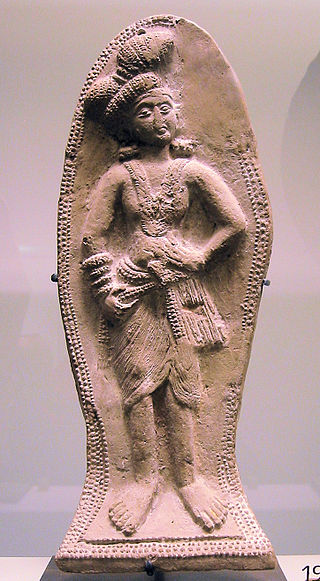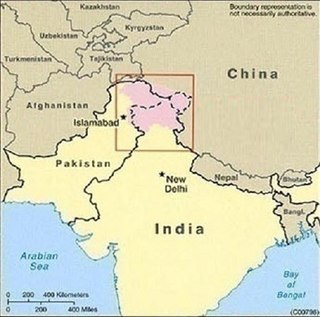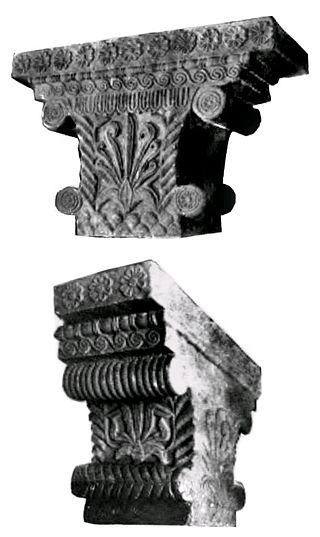
Demetrius I Anicetus, also called Damaytra was a Greco-Bactrian and later Indo-Greek king, who ruled areas from Bactria to ancient northwestern India. He was the son of the Greco-Bactrian Kingdom's ruler Euthydemus I and succeeded him around 200 BC, after which he conquered extensive areas in what is now southern Afghanistan, Iran and Pakistan and India.

The Maurya Empire was a geographically extensive Iron Age historical power in South Asia with its power base in Magadha. Founded by Chandragupta Maurya around c. 320 BCE it existed in loose-knit fashion until 185 BCE. The primary sources for the written records of the Mauryan times are partial records of the lost history of Megasthenes in Roman texts of several centuries later, the Edicts of Ashoka, which were first read in the modern era by James Prinsep after he had deciphered the Brahmi and Kharoshthi scripts in 1838, and the Arthashastra, a work first discovered in the early 20th century, and previously attributed to Chanakya, but now thought to be composed by multiple authors in the first centuries of the common era.

The Indo-Greek Kingdom, also known as the Yavana Kingdom, was a Hellenistic-era Greek kingdom covering various parts of modern-day Afghanistan, Pakistan and northwestern India.
The Shunga dynasty was the fifth ruling dynasty of Magadha and controlled most of the northern Indian subcontinent from around 187 to 75 BCE. The dynasty was established by Pushyamitra, after taking the throne of Magadha from the Mauryas. The Shunga empire's capital was Pataliputra, but later emperors such as Bhagabhadra also held court at Besnagar in eastern Malwa. This dynasty is also responsible for successfully fighting and resisting the Greeks in Shunga–Greek War.

Pushyamitra Shunga or Pushpamitra Shunga was the founder and the first ruler of the Shunga Empire which he established to succeed the Maurya Empire. His original name was Puṣpaka or Puṣpamitra and the confusion between Puṣyamitra and Puṣpamitra arose because of the erroneous readings of 'p' and 'y' in the manuscripts.

The Kanva dynasty or Kanvavamsha was a ruling dynasty of Magadha, established after Vasudeva Kanva overthrew the preceding Shunga dynasty and ruled from 73 BCE to 28 BCE.

Dasharatha Maurya was the 4th Mauryan emperor from 232 to 224 BCE. He was a grandson of Ashoka the Great and is commonly held to have succeeded him as the Emperor of Magadha. Dasharatha presided over a declining imperium and several territories of the empire broke away from central rule during his reign. He had continued the religious and social policies of Ashoka. Dasharatha was the last Mauryan emperor to have issued imperial inscriptions—thus the last Mauryan emperor to be known from epigraphical sources.

Kosala, sometimes referred to as Uttara Kosala was one of the Mahajanapadas of ancient India. It emerged as a small state during the Late Vedic period and became one of the earliest states to transition from a lineage-based society to a monarchy. By the 6th century BCE, it had consolidated into one of the four great powers of ancient northern India, along with Magadha, Vatsa, and Avanti.

Shalishuka Maurya was the 6th Emperor of the Indian Maurya dynasty. He ruled from 215–202 BCE. He was the successor and son of Samprati Maurya. While the Yuga Purana section of the Gargi Samhita mentions him as a quarrelsome, unrighteous ruler, he is also noted as being of "righteous words"

The History of the Indo-Greek Kingdom covers a period from the 2nd century BCE to the beginning of the 1st century CE in northern and northwestern Indian subcontinent. There were over 30 Indo-Greek kings, often in competition on different territories. Many of them are only known through their coins.
The Yuga Purana is a Sanskrit text and the last chapter of a Jyotisha (astrology) text Vriddhagargiya Samhita. It is also considered a minor text in the Puranic literature.
Agnimitra was the second Shunga Emperor who reigned over what is now northern and central India. He succeeded his father, the Emperor Pushyamitra in 149 BCE. The Vayu Purana and the Brahmanda Purana have assigned 8 years as the length of his reign.
Devabhuti, also known as Devbhomi, was the last Shunga Emperor in ancient India. He was assassinated by his minister Vasudeva Kanva. Following his death, the Shunga dynasty was then replaced by the subsequent Kanvas.

The sources which are used to reconstruct the history of the Indo-Greeks are few and disparate, leading to much uncertainty about the precise state of the Indo-Greek kingdom and its chronology. Sources related to the Indo-Greeks can be classified into various categories: ancient literary sources from both the West and the Indian world, archaeological sources from the general area of present day Pakistan, Kashmir and North Indian states of Punjab, Haryana, Himachal Pradesh, Uttar Pradesh & Bihar, and numismatical sources, which are abundant and well-preserved but often rather cryptic.

Jalauka was, according to the 12th century Kashmiri chronicle, the Rajatarangini, a King of Kashmir, who cleared the valley of oppressing Mleccha. Jaluka was reputed to have been an active and vigorous king of Kashmir, who expelled certain intrusive foreigners, and conquered the plains as far as Kannauj. Jalauka was devoted to the worship of the Hindu god Shiva and the Divine Mothers, in whose honour he and his queen, Isana-devi, erected many temples in places which can be identified.Ashoka’s death his mighty empire had fragmented into as many as four or five regional kingdoms each ruled by his sons or grandsons, among them Jalauka in Kashmir, who reversed his father’s policies in favour of Shaivism and led a successful campaign against the Greco-Bactrian Kingdom, themselves seeking to take advantage of the power vacuum in north-west India to reclaim Taxila.

Hellenistic influence on Indian art and architecture reflects the artistic and architectural influence of the Greeks on Indian art following the conquests of Alexander the Great, from the end of the 4th century BCE to the first centuries of the common era. The Greeks in effect maintained a political presence at the doorstep, and sometimes within India, down to the 1st century CE with the Greco-Bactrian Kingdom and the Indo-Greek Kingdoms, with many noticeable influences on the arts of the Maurya Empire especially. Hellenistic influence on Indian art was also felt for several more centuries during the period of Greco-Buddhist art.

Post-Mauryan coinage refers to the period of coinage production in India following the breakup of the Maurya Empire.

The Shunga-Greek War comprised several conflicts between the Shunga Empire and the Greco-Bactrian Kingdom. It is predominantly based on the Sanskrit play "Mālavikāgnimitram" by Kalidasa, which portrays events surrounding Pushyamitra Shunga.














